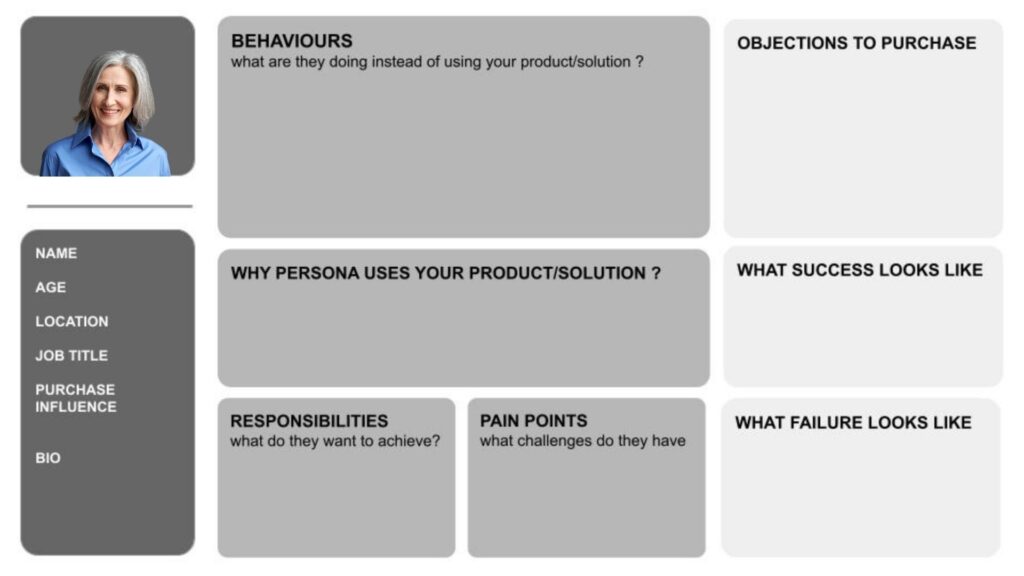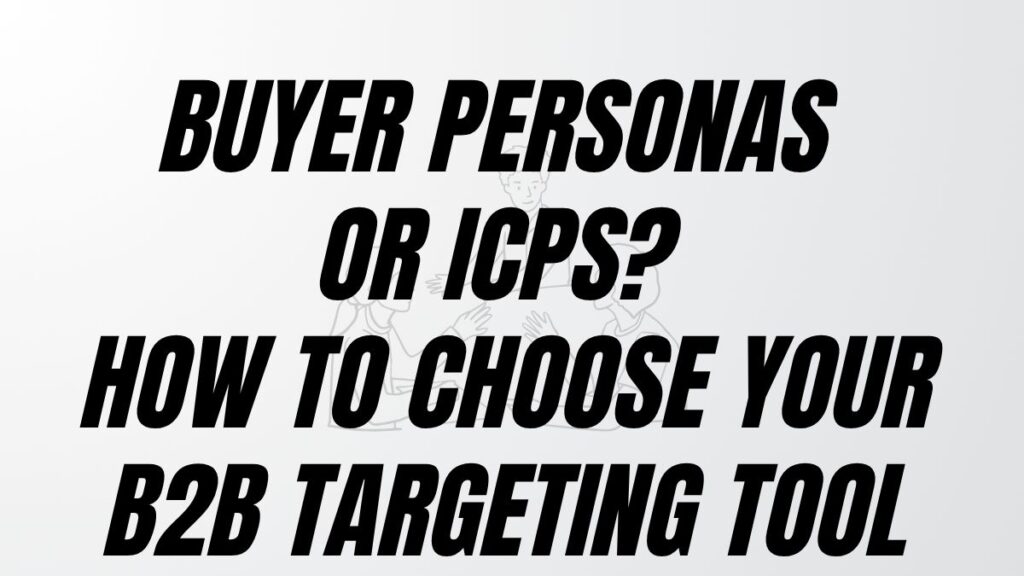Since 2012, I have been working mainly in the IT sector, with a strong focus on channel marketing for large IT vendors like SAP, IBM Software or Unit4. This blogpost is inspired by my own experience and I am used to doing workshops on Buyer Personas in IT with my clients.
In today’s rapidly evolving Information Technology (IT) landscape, where competition is fierce and customer expectations are higher than ever, understanding your audience is not just beneficial—it’s essential. This is where the concept of ‘personas’ comes into play, a strategy that has become increasingly vital for companies striving to stand out in the overcrowded IT sector.
In this blog post, we will delve into why personas are a game-changer in the IT industry. We’ll explore how they contribute to aligning product development with user needs, enhancing customer engagement, and ultimately, driving business success.
Whether you are looking to refine your existing marketing strategy or are just starting to explore the concept of personas, this guide will provide valuable insights into making personas a strategic asset in your IT business.

Why Personas Matter in IT
Personas are fictional characters, but their impact on business strategies is very real. They represent your ideal customers, crafted from a blend of market research and real data about your existing customers.
By embodying the needs, goals, challenges, and behaviour patterns of your target audience, personas enable companies to tailor their products and marketing efforts more effectively.
Personas offer a multi-dimensional view of potential customers. Therefore they go beyond basic demographics to reveal your customers’ attitudes, interests, behaviours, and motivations.
Beyond Demographics: The Depth of Personas
Examples of Personas
In marketing for IT, the concept of personas transcends the traditional confines of demographics, offering a multidimensional view of potential customers.
Unlike basic demographic data, which might include age, location, and income, personas delve deeper into psychographics – attitudes, interests, behaviours, and motivations.
For instance, a software vendor might create a persona named “Tech-Savvy Steve”, a mid-level manager in his thirties who values efficiency and is always on the lookout for software that can streamline his team’s workflow.
This persona goes beyond age and job title; it encapsulates Steve’s challenges, such as his struggle to manage a remote team, and his goals, like increasing productivity without overburdening his staff.
The depth of personas is particularly evident when examining their application in various IT scenarios. A software integrator, for example, might develop a persona like “Solution-Seeking Sara”, a CTO who prioritises seamless integration and data security.
This persona reflects not just Sara’s role but her specific pain points, such as the need to integrate legacy systems with new technologies, and her behaviour patterns, like her tendency to thoroughly research vendors before making a decision.
Startups, on the other hand, can benefit from personas like “Innovative Ian”, a young entrepreneur who is tech-savvy but lacks the budget for large-scale solutions. Ian represents a segment that seeks affordable, scalable solutions, a key insight for startups aiming to tailor their offerings to emerging businesses.
Benefits of Personas
These examples illustrate how personas, enriched with psychographic elements, enable IT companies to develop more targeted and effective marketing strategies.
According to a study by the ITSMA, 82% of companies using personas have improved their value proposition by understanding their customers better.
Furthermore, using personas can make websites 2-5 times more effective and easier to use by targeted users.
By embracing the depth of personas, IT companies can move beyond generic strategies. They can craft solutions and communications that resonate deeply with their target audience.

How to Create Detailed Buyer Personas for Your Business by Hubspot
Aligning Product Development with User Needs
Aligning product development with user needs is not just a strategy, but a necessity for success, first and foremost in the IT sector. Personas play a crucial role in this alignment, acting as a compass that guides the development process towards creating solutions that resonate with the target audience.
In order to better understand the concept of Personas, we will take a few examples.
First, let’s consider a software vendor specialising in project management tools.
By developing a persona like “Project Manager Paula,” who struggles with coordinating remote teams and needs intuitive, collaborative features, the company can tailor its software to address these specific challenges.
This approach ensures that the end product is not just a technological marvel but a solution that genuinely solves real-world problems.
The impact of personas in product development is even more pronounced in niche markets. A case in point is the development of healthcare IT solutions. A persona like “Healthcare Administrator Alex”, concerned with patient data security and efficient record management, can guide developers to prioritise features like robust encryption and user-friendly interfaces. More generally 95% of surveyed people would remain customers if their CX was rated outstanding.
Moreover, startups can leverage personas to identify unmet needs in the market. For example, a startup creating a budgeting app for small businesses might use a persona like “Entrepreneur Emily”, who lacks financial expertise and needs a simple yet comprehensive budgeting tool. This persona-driven development can lead to innovative features like automated expense tracking or integrations with popular e-commerce platforms, directly addressing Emily’s needs.
These examples underscore the value of personas in ensuring that product development is closely aligned with user needs. By grounding product development in the realities of their personas’ lives, IT companies can create solutions that not only meet but exceed user expectations, fostering loyalty and driving business growth.
Enhancing Customer Engagement and Loyalty
In the IT sector, where customer options are abundant and switching costs are low, enhancing customer engagement and loyalty is paramount.
Personas are instrumental in this endeavour, as they enable companies to tailor their interactions and forge deeper connections with their customers. For instance, a cloud services provider might use a persona like “IT Manager Mike”, who is not only tech-savvy but also values high-level customer support and educational resources.
By understanding Mike’s preferences and pain points, the company can personalise its communication, offering targeted tutorials and dedicated support, thereby increasing Mike’s engagement and loyalty.
The effectiveness of personas in enhancing customer relationships is evident across various IT niches. Take, for example, a cybersecurity firm. By developing a persona like “Security-Conscious Sandra”, who is vigilant about protecting company data but struggles to keep up with evolving threats, the firm can create customised content and solutions that address her specific concerns, thereby fostering trust and loyalty.
According to a study by Econsultancy, companies that work towards improving customer experience see a 55% increase in customer loyalty.
Startups, too, can leverage personas to build a loyal customer base from the ground up. A startup offering innovative AI solutions might focus on a persona like “Tech-Forward Tom”, an early adopter always looking for cutting-edge technology. By engaging Tom with beta testing opportunities and exclusive previews, the startup can create a sense of belonging and loyalty.
These examples highlight the power of personas in enhancing customer engagement and loyalty. A report by Salesforce indicates that 84% of customers say being treated like a person, not a number, is key to winning their business.
By using personas to personalise interactions and solutions, IT companies can create more meaningful and lasting relationships with their customers, leading to increased loyalty and, ultimately, sustained business growth.
How To Create Accurate Buyer Personas in IT in 7 Steps
Step 1 – Gather Comprehensive Data
First, start by collecting a wide range of data from various sources to better understand your target audience. This includes:
- Customer Surveys and Interviews: Direct feedback from current and potential customers provides invaluable insights into their needs, preferences, and challenges.
- Sales and Customer Support Teams: These teams interact directly with customers and can offer insights into common questions, concerns, and feedback.
- Analytics and Social Media: Analyse data from your website, social media platforms, and other digital touchpoints to understand how users interact with your brand online.
- Market Research: Stay updated with industry trends, competitor analysis, and market shifts to anticipate changes in customer needs and preferences.
Step 2 – Segment Your Audience
Next, use your collected data to segment your audience based on shared characteristics, behaviours, and needs. This process may involve demographic, psychographic, and behavioural criteria. Segmentation helps in creating more focused and detailed personas.
Step 3 – Create Detailed Personas
Then, develop detailed buyer personas that include demographics, goals, challenges, preferences, and behaviours specific to your IT products or services. You can use persona templates to organise and present this information effectively.
Step 4 – Validate and Refine Personas
After creating personas, gather feedback from real users. Share your personas with real customers or prospects through surveys or interviews to validate assumptions and gather additional insights.
Additionally, engage marketing, sales, and product teams to ensure the personas resonate with their experiences and insights. You can also use A/B testing and analyse engagement metrics to see how well personas align with actual customer behaviour and preferences.
Step 5 – Continuous Monitoring and Updating
Moreover, buyer personas are not static; they need to evolve with your market, products, and customer base. Regularly review and update your personas based on:
Product Evolution: Update personas as you introduce new features, products, or services that might attract different customer segments.
New Customer Data: Incorporate fresh insights from ongoing customer feedback and analytics.
Market Changes: Adjust personas in response to new trends, technologies, and competitive dynamics in the IT sector.
Step 6 – Use AI and Machine Learning
Consider leveraging AI and machine learning tools to analyse large datasets and identify patterns or segments you might have missed. These technologies can also help in predicting future trends that could impact your buyer personas.
Step 7 – Stakeholder Collaboration
Finally, ensure continuous collaboration among all stakeholders involved in persona creation and usage. This includes marketing, sales, product development, and customer service teams. Regular workshops and meetings can help align everyone’s understanding and use of buyer personas.
In Conclusion
The effective use of buyer personas is a cornerstone in understanding and engaging with your target market. Personas provide a rich tapestry of insights into customer psychographics, behaviours, and preferences. Remember that personas are not static; they are dynamic entities that evolve as the market changes. By using personas to inform your business decisions, you can connect with your customers, anticipate market changes, and innovate with precision.
The success stories of IBM, Mailchimp, SAP, and Dropbox underscore the transformative impact of personas. These companies have harnessed the power of well-crafted personas to achieve remarkable outcomes, from increased sales and user engagement to market leadership and rapid growth.
These achievements highlight the potential of personas to not only guide product development and marketing strategies but also to carve out niche markets and establish unique selling propositions.
FAQs About Buyer Personas so important in IT
How do buyer personas go beyond basic demographics?
Personas delve into psychographics, revealing attitudes, interests, behaviours, and motivations, providing a comprehensive view of customers beyond age, location, and income.
How do personas assist in aligning product development with user needs?
By understanding specific customer challenges and goals, companies can tailor products to meet actual user requirements, ensuring relevance and effectiveness.
In what ways do personas enhance customer engagement?
They enable personalised marketing efforts, addressing specific pain points and preferences, leading to more meaningful interactions and stronger customer relationships.
What role does data play in developing buyer personas?
Data provides insights into customer behaviours, preferences, and challenges, forming the foundation for creating realistic and effective personas.
Why is it important to continuously update buyer personas?
Customer behaviours and market dynamics evolve; regularly updating personas ensures they remain accurate and relevant for strategic decision-making.





